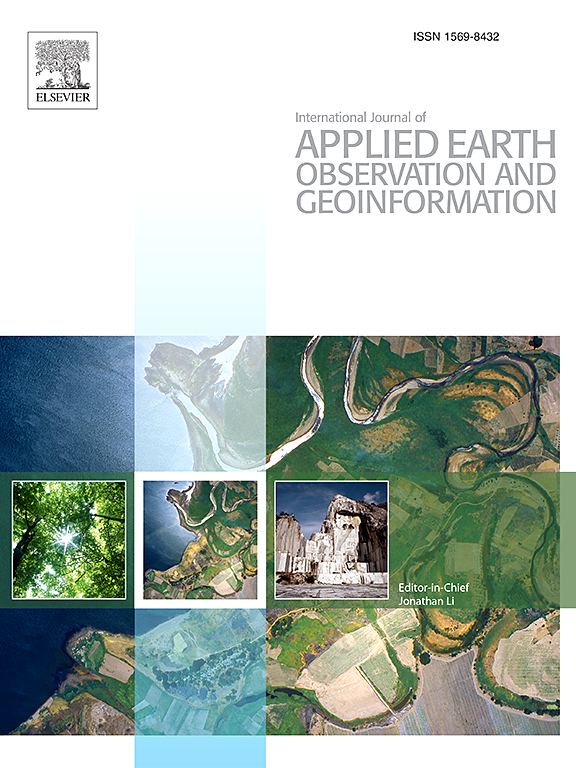A new method for rapid construction of multi-band vegetation index
IF 7.6
Q1 REMOTE SENSING
International journal of applied earth observation and geoinformation : ITC journal
Pub Date : 2025-05-15
DOI:10.1016/j.jag.2025.104601
引用次数: 0
Abstract
The aboveground dry biomass (AGDB), leaf area index (LAI), chlorophyll density (CHD), and plant water content (PWC) are important growth physiological parameters that can reflect the growth status of winter wheat. Monitoring the growth physiological parameters of winter wheat by constructing vegetation index is a common method that can quickly obtain the growth physiological parameters of winter wheat. In order to further improve the accuracy of using vegetation index method to monitor the growth physiological parameters of winter wheat, this study proposed a new method based on the genetic algorithm that can quickly construct multi-band vegetation index. The main results were as follows: Compared with the traditional random bands combination to construct the vegetation index, the results of using the rapid method proposed in this study to construct the vegetation index were reliable, and can greatly reduce the time required to construct the vegetation index, which only took about 17.7044 s on average. In the four arithmetic operations used, the priority should be given to Subtraction(Sub.) and Division(Div.), combined with Addition(Add.) and Multiplication(Mul.) operations to construct multi-band vegetation index can achieve good monitoring results. In this study, AGDB, LAI, CHD, and PWC reached the highest accuracy when using ’Sub.-Add.-Sub.-Sub., ’Div.-Div.-Mul.-Mul.’, ’Sub.-Add.-Sub.-Add.’, and ’Div.-Sub.-Div.-Add.’ to construct the five-band vegetation index, respectively, with validation R2 (R2v) of 0.6104, 0.6849, 0.7019, and 0.8960, and validation RMSE (RMSEv) of 0.4508, 2.1025, 1.1473, and 3.4683. Using ’Sub.-Add.-Sub.-Sub.’ to construct five-band vegetation index could simultaneously monitor four growth physiological parameters. The R2v of AGDB, LAI, CHD, and PWC monitored by it was 0.6104, 0.6326, 0.6791, and 0.8425 respectively, and the RMSEv was 0.4508, 2.2702, 1.1903, and 4.2692, respectively. In a word, using the rapid method proposed in this study to construct vegetation index can not only greatly reduce the time required to construct vegetation index, but also has high reliability and reliable operation results.
一种快速构建多波段植被指数的新方法
地上部干生物量(AGDB)、叶面积指数(LAI)、叶绿素密度(CHD)和植株含水量(PWC)是反映冬小麦生长状况的重要生长生理参数。通过构建植被指数对冬小麦生长生理参数进行监测是一种快速获取冬小麦生长生理参数的常用方法。为了进一步提高利用植被指数法监测冬小麦生长生理参数的准确性,本研究提出了一种基于遗传算法的快速构建多波段植被指数的新方法。主要结果如下:与传统随机波段组合构建植被指数的方法相比,采用本文提出的快速方法构建植被指数的结果可靠,并且可以大大缩短构建植被指数所需的时间,平均仅需17.7044 s左右。在使用的四种算术运算中,应优先考虑减法(Sub.)和除法(Div.)运算,结合加法(Add.)和乘法(Mul.)运算构建多波段植被指数,才能取得良好的监测效果。在本研究中,AGDB、LAI、CHD和PWC在使用“Sub.-Add.-Sub.-Sub”时准确率最高。Div.-Div.-Mul.-Mul。”、“Sub.-Add.-Sub.-Add。’和‘Div.-Sub.-Div.-Add.’。,分别构建五波段植被指数,验证R2 (R2v)分别为0.6104、0.6849、0.7019和0.8960,验证RMSE (RMSEv)分别为0.4508、2.1025、1.1473和3.4683。使用“Sub.-Add.-Sub.-Sub。构建的五波段植被指数可以同时监测四种生长生理参数。其监测的AGDB、LAI、CHD、PWC的R2v分别为0.6104、0.6326、0.6791、0.8425,RMSEv分别为0.4508、2.2702、1.1903、4.2692。总之,采用本研究提出的快速构建植被指数的方法,不仅可以大大减少构建植被指数所需的时间,而且可靠性高,运行结果可靠。
本文章由计算机程序翻译,如有差异,请以英文原文为准。
求助全文
约1分钟内获得全文
求助全文
来源期刊

International journal of applied earth observation and geoinformation : ITC journal
Global and Planetary Change, Management, Monitoring, Policy and Law, Earth-Surface Processes, Computers in Earth Sciences
CiteScore
12.00
自引率
0.00%
发文量
0
审稿时长
77 days
期刊介绍:
The International Journal of Applied Earth Observation and Geoinformation publishes original papers that utilize earth observation data for natural resource and environmental inventory and management. These data primarily originate from remote sensing platforms, including satellites and aircraft, supplemented by surface and subsurface measurements. Addressing natural resources such as forests, agricultural land, soils, and water, as well as environmental concerns like biodiversity, land degradation, and hazards, the journal explores conceptual and data-driven approaches. It covers geoinformation themes like capturing, databasing, visualization, interpretation, data quality, and spatial uncertainty.
 求助内容:
求助内容: 应助结果提醒方式:
应助结果提醒方式:


